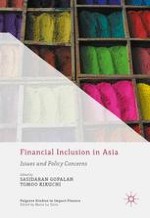2016 | OriginalPaper | Chapter
4. Financial Inclusion and Monetary Policy in Emerging Asia
Authors : Aaron Mehrotra, G. V. Nadhanael
Published in: Financial Inclusion in Asia
Publisher: Palgrave Macmillan UK
Activate our intelligent search to find suitable subject content or patents.
Select sections of text to find matching patents with Artificial Intelligence. powered by
Select sections of text to find additional relevant content using AI-assisted search. powered by
